Peony: reproduction, care and transplant in spring
Peony is herbaceous perennial... It belongs to the peony family. There are about 40 varieties of this plant. Distributed peonies in the territories of Eurasia and North America. Their homeland is China, where they began to plant peonies more than 2 thousand years ago.
In appearance, the plant can be a tree-like or herbaceous shrub, or bush... Peony stems grow up to 1 meter in height. The branches are large, strong, thick. They have trifoliate leaves, the color of which, depending on the variety, can be from green to purple. The flowers are large, located at the ends of the branches, their diameter can be up to 20 cm. The root system is powerful. At home, mainly herbaceous species of peonies are grown.
Content:
Peony varieties
The most popular varieties of peonies for growing:
- Peony Adolphe Russo. A large variety with a compact bush, the branches of which stretch up to 100 cm in height. The leaves are trifoliate, large, painted in a dark green tone with a red tint. The flowers are large, the petals are dark red and alternate with yellow stamens. The buds open in early summer.
- Peony Alexander Fleming. A large shrub with strong stems that branch slightly. The flower is full, large, 12 cm in diameter, the petals are pink. They have a delicate aroma. The flowering period begins in late spring or early summer, depending on the weather.
- Peony Alice Harding. The bush is undersized, the height of the stems reaches only 50 cm. The branches are spreading. The flowers are large, full, the petals are white with pink edges. The flowering period begins in early summer and lasts 2 weeks.
- Peony Barzella... The bush is medium in size, its height reaches 70-80 cm. It has large flowers up to 25 cm in diameter. The petals are painted in a pale yellow color, when the bud is fully blooming, pink blotches are visible in the center. The flower in the middle is empty and has a pleasant lemon scent. Stems are thick, erect, strong. The variety is distinguished by abundant flowering; one bush can have up to 50 buds.
Peony care
Peonies unpretentious plants, but choose a place for them landing necessary carefully. The bush must be protected from wind and draft. It is not recommended to plant peonies close to the house. Since the heat that comes from the building will overheat the bush and roots. The soil should be fertile and well-drained, and the site should be on a hill. Lighting should be constant, shading 2-4 hours a day.
Peonies do not tolerate swampy soil well, being in water for a long time, the roots rot, which leads to the death of the bush.
Therefore, watering should be moderate throughout the spring and autumn period. When buds are tied on the bushes, it is necessary to ensure that the soil around the bush does not dry out completely, as this can lead to the death of the flowers. The rest of the time, the plant is watered once every 7-10 days, depending on weather conditions.
Plant feeding:
- Adult bushes need feeding.
- Young, recently transplanted peonies are not recommended to fertilize abundantly and feed.
- You can apply organic and mineral fertilizers containing calcium and phosphorus.
Transplanting peonies in spring
Peonies can be transplanted in the spring or autumn. After flowering peonies, the best period for planting and transplants will be the month of September. At this time, the heat subsides, and new buds form on the bushes. The bush is dug up, divided into several parts and planted in prepared holes. Transplanting peonies in the fall guarantees a wild bloom in the spring.
Transfer peonies in the spring it is more difficult:
- There is no specific month, as the whole process adjusts to the weather.
- When the first sunny days begin and the snow has almost completely melted, the bush can be removed from the ground along with a lump.
- In the spring, the bush cannot be divided, nor can the roots be washed or shaken off the ground. After winter, the roots are weak and brittle and any wrong movement can damage the bush.
- A bush with an earthen lump is placed in a previously prepared hole with loose earth mixed with nutrients.
- Rotten compost is good for this.
- Stronger fertilizers and top dressing are not recommended during this period.
- The transplanted bush must be watered regularly so that the ground around does not dry out too much, but also to avoid excessive moisture.
The bushes must be prepared for winter. 5-7 days after the end of the flowering of the entire bush, it is fed with phosphorus-potassium fertilizers. When cold weather sets in, the entire aerial part of the plant is cut off. In regions where the temperature drops below -15 degrees during the winter months, it is recommended to insulate the bush with autumn leaves or sawdust.
Reproduction of peonies
Peonies reproduce using seed, root cuttings and dividing the bush... With the help of seeds, these plants are propagated only by breeders. This is a rather laborious and long process, in which the resulting plants do not retain the characteristics and external data of the mother bush.
When propagating by root cuttings, it is necessary in the middle of summer to separate the part of the root on which the dormant bud is located.
This piece is planted in a pre-prepared rooting hole. By the fall, the roots should take root. The disadvantage of this method is that such bushes bloom only 5 years after planting.
Dividing a bush is the simplest and most common way to propagate peonies:
- The bushes are chosen by adults who have bloomed profusely for 2-3 years in a row.
- In late summer or early autumn, when the heat subsides, you can start the breeding process of peonies.
- The bush digs in at a distance of 20–25 cm and is carefully removed from the ground.
- In this case, it is necessary to cut off all the stems and branches at the root. The earth is gently crushed.
- The roots are washed, the bad ones are removed and the old ones are pruned.
- It is necessary to divide the bush carefully so that 3-4 eyes remain on the separated root.
- For disinfection, the roots can be treated with a solution of potassium permanganate.
Peonies can be infected powdery mildew or gray mold. Such diseases can appear on plants with improper care, excess moisture and nitrogenous substances in the soil. Special drugs the bush and all plants growing nearby are processed. In some cases, the bushes are transferred to a more suitable place or planted.
More information can be found in the video.



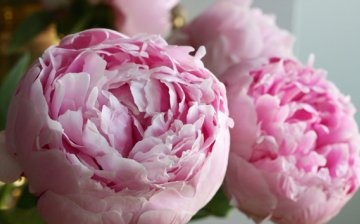

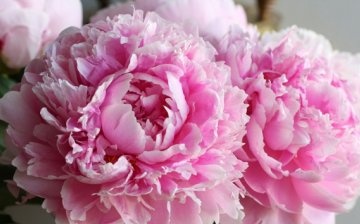

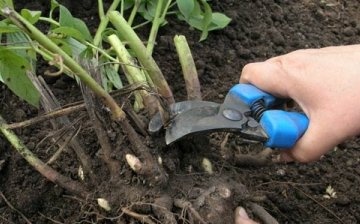





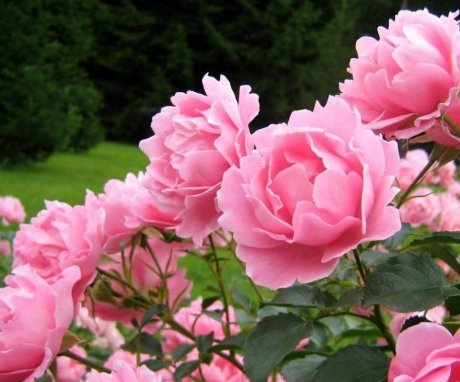
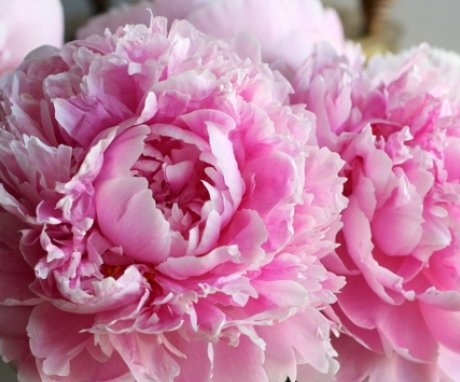

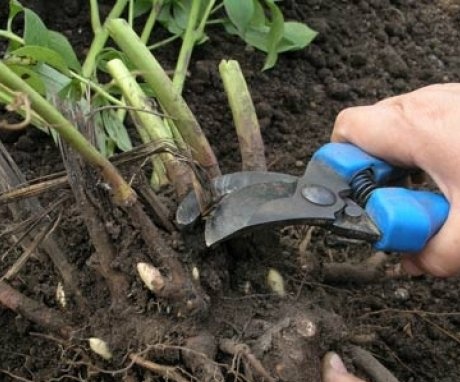
I really like this flower. But I always hear conflicting reviews from friends - someone succeeds in achieving abundant flowering of peonies and successfully propagating them, while someone has tried to grow it more than once, but to no avail.